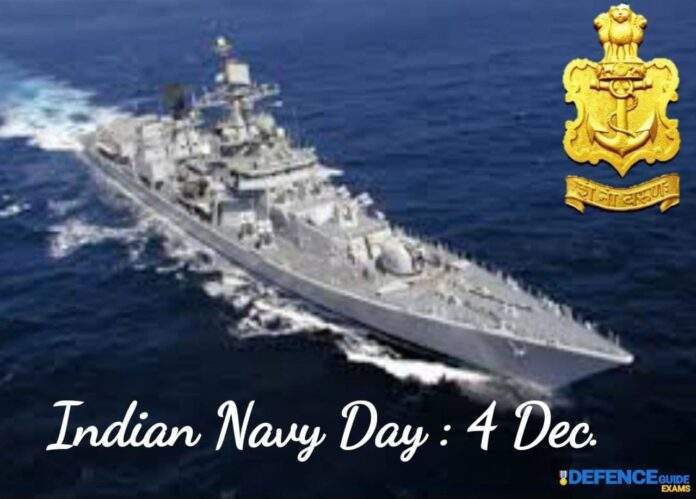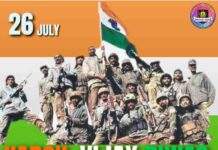Indian Navy Day 4 December all you need to know. India has a rich maritime heritage, and the Rig Veda contains the earliest reference to maritime activities. Indian mythology has numerous episodes pertaining to the ocean, the sea, and the rivers. There is plenty of evidence derived from Indian literature, art, sculptures, painting, and archaeology to establish the existence of maritime traditions. A study of the country’s maritime history reveals that the Indian sub-continent exercised supremacy over the Indian Ocean from early to the 13th Century. As we celebrate the Swarnim Vijay Varsh, marking the 50th year of India’s historic victory in the 1971 war, let us know more about the Indian Navy.
Historical Background
On October 21, 1944, the then Royal Indian Navy celebrated Navy Day for the first time. The idea behind celebrating Navy Day was to foster greater outreach and increase awareness about the Navy. The celebrations involved conducting parades at various port cities and holding public meetings at inland centers. The initiative garnered considerable success and aroused great enthusiasm among the public. Taking a cue from this success, the Royal Indian Navy decided to organize similar functions every year on a larger scale. It was also decided to shift the date to a time when the weather would be more pleasant. Accordingly, Navy Day in 1945 was celebrated at Bombay and Karachi on December 1.
With the partition of India, postindependence, the Royal Indian Navy got divided into the Royal Indian Navy and the Royal Pakistan Navy. With India becoming a Republic on 26th January 1950, the prefix ‘Royal’ was dropped, and the force was rechristened as the Indian Navy. On 26th January 1950, the Crown of the Royal Indian Navy’s Crest was replaced by the Ashoka Lion Motif for the Indian Navy’s Emblem. Invoking Lord Varuna (The Sea God as mentioned in the Vedas), the Indian Navy adopted the motto: “Sam no Varunah,” meaning: “Be auspicious unto us Oh Varuna!”. Also, the inscription of “Satyamev Jayate” was placed below the State Emblem in the Indian Navy’s Crest. Until 1972, India celebrated Navy Day on 15th December. The week in which the date fell was observed as the Navy Week. In May 1972, the Senior Naval Officers Conference decided to celebrate Navy Day on 4th December to commemorate the successful naval actions in the Arabian Sea and the Bay of Bengal during the 1971 India-Pakistan War and celebrate Navy Week from 1st to 7th December.
1971 War
4th December has great significance in the history of India and the Indian Navy as it marks a decisive victory for India when the boats of the Indian Navy, during Operation Trident in the 1971 IndiaPakistan War, successfully fired their missiles onto ships, oil installations, and shore defense installations of Pakistan at Karachi. During the 1971 operations, the Indian Navy sunk many Pakistani ships carrying war logistics and critical equipment. The fighter aircraft from the deck of INS Vikrant struck at the enemy harbors and airfield at Chittagong and Khulna, destroying ships, defense facilities, and installations. Both the missile strikes at Karachi and air attacks from Vikrant led to the defeat of Pakistani Forces in East Pakistan.
Operation Trident:
This operation comprised the first missile attack on Karachi harbor, on the night of 04/05 December 1971, by Indian Naval Ships Kiltan, Katchall, Nipat, Nirghat and Veer. During the maiden missile boat operation after independence, the Indian Navy destroyed and sank PNS Khyber (a Pakistani destroyer), PNS Muhafiz (a coastal minesweeper), and merchant vessel MV-Venus Challenger. This operation was also a watershed in ingenuity and strategic thinking as the Indian Navy used its Aircraft Carrier INS Vikrant to tow these smaller missile boats close to the Pakistani ports. This strategy brought the ports within the missile range of the boats, a move unthinkable until then.
Operation Python:
Indian Naval Ships Trishul, Talwar, and Vinash carried out the second missile attack on Keamari oil field at Karachi on 08/09 December 1971. The Indian Navy set ablaze oil tanks during the attack, sank two merchant vessels (Harmatton and Gulf Star), and destroyed Pakistan Navy’s tanker PNS Dacca. With the attack, the Indian Navy achieved maritime dominance off the approaches to Karachi.
Operation Beaver:
In this significant joint-amphibious operation, the Naval task force established a total blockade in the Bay of Bengal, and the Eastern Army Command rapidly advanced into East Pakistan (04-08 December 1971) following a clever assessment that the Pakistani troops, to prevent arrest, would attempt to escape southward into Burma through Cox’s Bazaar. Accordingly, an amphibious landing was conducted on 15th December 1971 at Cox’s Bazaar by two Indian Landing Ship Tanks (LST), INS Gharial and Guldar. The ‘Romeo Force’ contingent, which embarked on board the LST consisted of 1/3 Gorkha Rifles, 02 companies of 11 Bihar, 881 Light Battery, an Ambulance Platoon, and an ASC Detachment. The LSTs landed a part of the ‘Romeo Force’ at Reju Creek near Cox Bazaar. These forces subsequently cordoned off the southern approaches from East Pakistan to achieve strategic advantage during the war. Action by the Indian Armed forces led to the emergence of Bangladesh as an independent nation.










